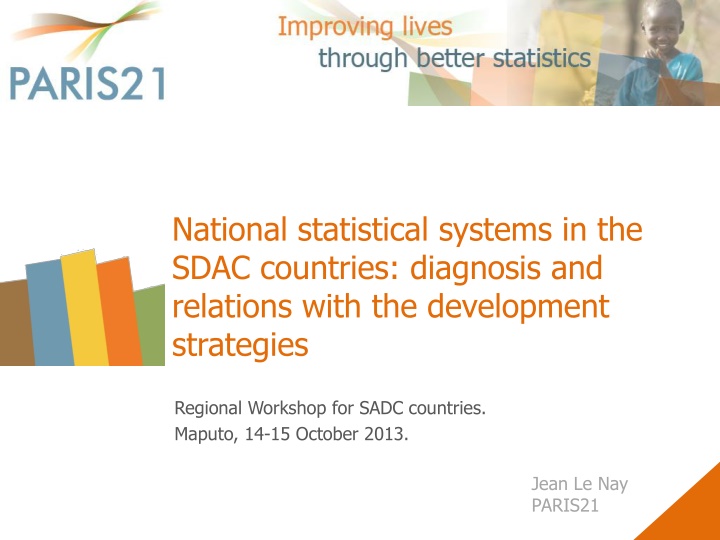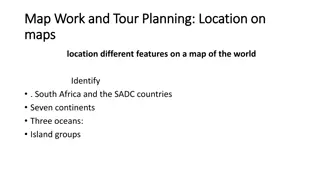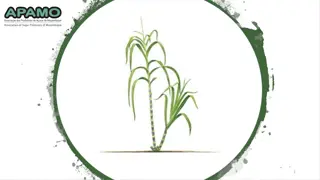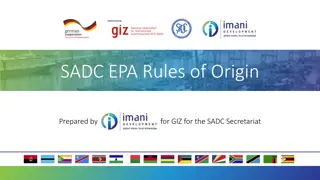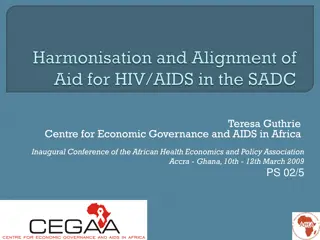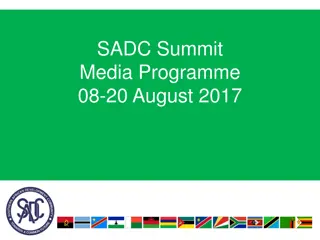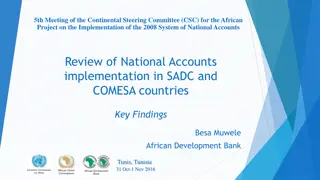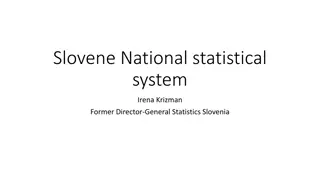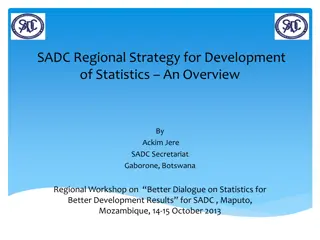National Statistical Systems in SADC Countries: Diagnosis and Development Strategies
Presentation on the main features, constraints, NSDSs, users, data production, and relations between NSS and development units in SADC countries. Focus on resources, human factors, NSDS impact, user engagement, and initiatives for statistical development.
Download Presentation

Please find below an Image/Link to download the presentation.
The content on the website is provided AS IS for your information and personal use only. It may not be sold, licensed, or shared on other websites without obtaining consent from the author.If you encounter any issues during the download, it is possible that the publisher has removed the file from their server.
You are allowed to download the files provided on this website for personal or commercial use, subject to the condition that they are used lawfully. All files are the property of their respective owners.
The content on the website is provided AS IS for your information and personal use only. It may not be sold, licensed, or shared on other websites without obtaining consent from the author.
E N D
Presentation Transcript
National statistical systems in the SDAC countries: diagnosis and relations with the development strategies Regional Workshop for SADC countries. Maputo, 14-15 October 2013. Jean Le Nay PARIS21
Plan of the Presentation : 1. Main features/constraints in the SADC countries; 2. NSDSs; 3. The Users; 4. The data production; 5. Relations between NSSs and Development Units 6. Conclusions . Maputo regional workshop - Oct. 2013
1-NSSs: THE MAIN FEATURES IN THE SADC COUNTRIES Scope of the survey :12 countries DRC and Madagascar participated in the Abidjan workshop Internal resources for NSOs: 5 million-12 million US $ NSOs employees: 230-540 Average per capita internal resources for NSOs: 0.50 $ External resources: needed in all but two countries. In 8 countries, resources are stable or decreasing in 2010-2013. Maputo regioanl workshop - Oct. 2013 (1
NSSs: THE MAIN CONSTRAINTS Human resources mentioned in 10 countries; Insufficient equipment: 8 countries; Demotivation of the employees: 5 countries; Lack of production factors to provide the data expected by the users; Human resources: a quantitative and qualitative dimension; Need for a HR approach. (2 Maputo regioanl workshop - Oct. 2013
2-THE NSDSs NSDS is the reference framework for statistical programming in the SADC countries; Adopted by all the countries, with 3 countries at the design phase; 4 countries are implementing a first generation NSDS; NSDS improves the status of statistics in the country and increase the relations among the official data providers (NSS). Impact of NSDSs: the weakest point. 1 (3 Maputo regioanl workshop - Oct. 2013
3-THE USERS (a) NSDS approach implies a participative dimension; Users are partners in the design phase in all the countries. No details on the other phases; Major partner among users: mass media; Private sector, researchers/Universities, and civil society: more difficult. 1 (4 Maputo regioanl workshop - Oct. 2013
3-THE USERS (b) Specific initiatives vis- -vis the users: Media relations unit; monthly meeting with the media; consultation with users on statistics to be collected; focus groups to identify gaps; courses on statistical interpretation. NSO Websites: in 11 countries. 1 (5 Maputo regioanl workshop - Oct. 2013
4-DATA PRODUCTION : N.A. 8 countries have definitive accounts for 2011. In 1 country the last definitive N.A. available is for 2008; Base year of N.A.: 3 countries with base year older than 10 years; 11 countries use the 1993 SNA; 2008 SNA: 1 country; mix of 1968-1993: 1country. 1 (6 Maputo regioanl workshop - Oct. 2013
5- NSSs AND PRSP OR STRATEGIC DEVELOPMENT UNITS (a) PRSPs and HIPC initiative on debt relief; PRSPs are very demanding: poverty profile, targets, indicators; Poverty remains an issue after the debt relief; In 2013 all the countries implement or prepare development strategies including a poverty reduction component with quantitative targets on specific poverty issues. 1 (7 Maputo regioanl workshop - Oct. 2013
5-NSDS AND PRSP OR STRATEGIC DEVELOPMENT UNITS(b) NSDSs were responses to the data needs of the PRSPs : In most of the SADC countries there is no formal articulation between NSDS and development strategy; 3 countries only have inserted the NSDS into the developement strategy (2 with an action plan and resources). 1 (8 Maputo regioanl workshop - Oct. 2013
5-NSDS AND PRSP OR STRATEGIC DEVELOPMENT UNITS (c) NSOs are major partners in the design and monitoring/evaluation dimensions of the developmentstrategy; NSOs provide data for the reference year, help to choose the targets, and to calculate the indicators; Strategic Development Units request: more frequent data on poverty; alignment of surveys with the planning cycle; more timeliness, regularity; reliability and credibility of the indicators. 1 (9 Maputo regioanl workshop - Oct. 2013
NSDS AND PRSP OR STRATEGIC DEVELOPMENT UNITS(d) The expectations of the strategic development offices are strictly linked to the preparation and monitoring/evaluation of the development strategy. 1 office only expresses wider expectations: the statistics office is expected to promote wide access to and use of data, in order to foster dissemination and evidence-based dialogue. There are annual reports on the strategy implementation in most countries (5 do not prepare reports); 2 have specific websites. (10 1 Maputo regioanl workshop - Oct. 2013
CONCLUSION (a) Since 2000, an important evolution of the NSSs took place, mostly based on the NSDS approach: more autonomy; recognition of the importance of statistics; more resources; more open to users; more data production; new instruments and techniques. (11 1 Maputo regioanl workshop - Oct. 2013
CONCLUSION (b) Comparison with the 16 countries reviewed at Abidjan in September 2012; At the Abidjan Workshop, the countries have: Adopted the NSDS approach earlier; More frequently integrated the NSDS in the strategic development documents. At the Maputo workshop, the NSOs: have more resources and employees; Are less dependent on external resources; Have more relations with the media. 1 (12 Maputo regioanl workshop - Oct. 2013
CONCLUSION (c) Challenges for the NSSs: Improvement of governance and independence; Systematization of the programming approach; Involvement of the users beyond the preparation phase; Unification and coordination of the official data providers; Coordination of the donors; Dissemination of data to all the users based on the most updated communication techniques; Face the demands linked to cross-cutting themes : inequalities; discrimination; environment and sustainability; population dynamics; governance; human rights Prepare the new world challenges => Putting statistics at the heart of the post-2015 debate. 1 (1 3 Maputo regioanl workshop - Oct. 2013
